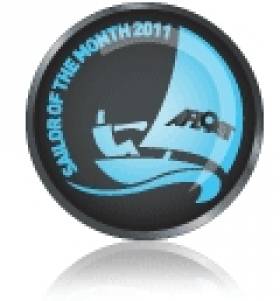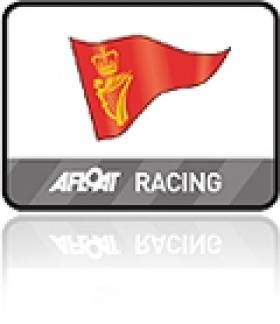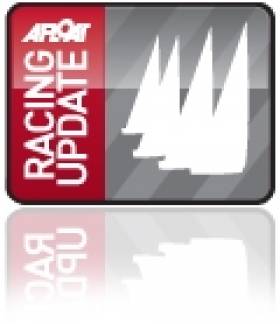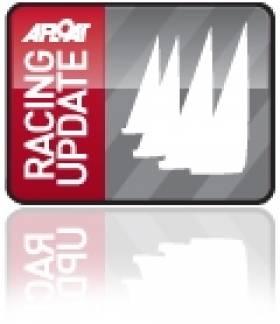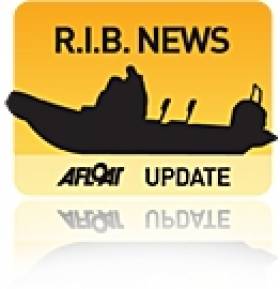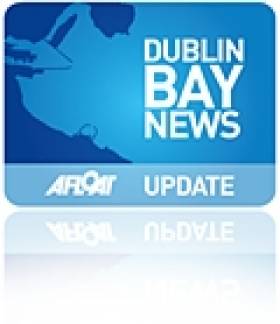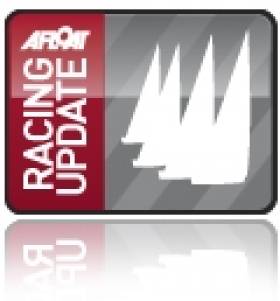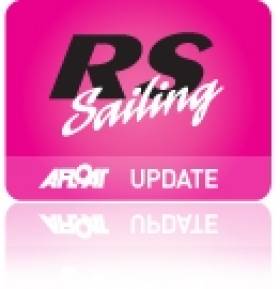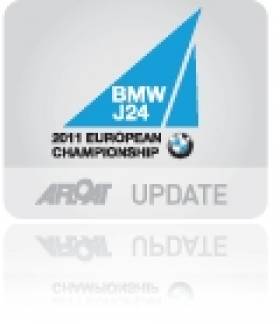Displaying items by tag: Club
Matt Davis is September's Sailor of the Month
The welcome revival of the offshore racing programme in the Irish Sea has been steered by Peter Ryan of the National Yacht Club in Dun Laoghaire, but without the enthusiastic crew like the Skerries squad, it just wouldn't happen.
Apart from the continuous effort of keeping a frontline offshore racer and all her equipment in sound working order, the demands on personnel for time in this crowded era can be quite exceptional. The logistics are formidable, as the regular cross channel ISORA programme is based on a willingness to alternate between starting points on the Welsh and Irish coast.
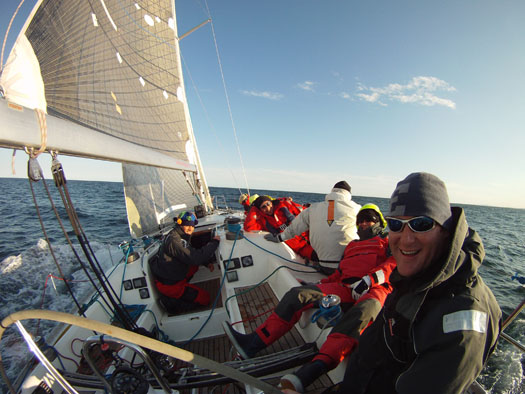
Matt Davis and crew on board Raging Bull in one of this year's ISORA races. Photo: Brian Carlin
For boats heading for an away start, it often involves an overnight passage beforehand. In the case of Raging Bull, all starts are away events, as the programme does not as yet take in Skerries. But we can hope that this will change in the future, as the nucleus of a Fingal offshore racing group develops around the Davis success.
With the summer of 2011's uneven weather, Raging Bull's crew had to be fit and ready to take full advantage of their boat's proven ability in rugged weather, while at the same time managing to turn in a respectable performance in light airs.
For the first time, the biennial Dun Laoghaire-Dingle race was recognized as an ISORA event, and Davis and his crew revelled in it. For much of the race they were the only boat mounting a significant challenge to the pace setter, Martin Breen's Reflex 38 Galway Harbour. Though the Skerries boat had to be content with the runner-up slot to the Galway boat in Dingle, they were first of all the ISORA participants, a top score which stood well to them when they continued with the Irish Sea programme right up until mid-September. Despite the limited size of the harbour, the maritime spirit of Skerries is manifesting itself in many areas of sailing, and Matt Davis's achievement is typical of the special Fingal fervour.
More on Matt's 2011 victory in Autumn Afloat magazine out next week!More ISORA News here
Sharkbait Wins By a Single Point at SB3 National Championships
The young pretender Ross Vaughan RNIYC took line honours in race one. But it was the experience of 1988 and 1992 Olympian Peter Kennedy who lead after day one with two wins. Hot on his heels going into Saturday were top Irish performer at this year's worlds, Mel Collins of RCYC sailing Sibelus, and last year's Champion Gareth Flannigan from Ballyhome YC.
Day two which ended up as the final day, included the first two races in the north of Dublin Bay. Jack Roy moved the fleet towards Dalkey Island for the final race.
A second place by RIYC Alan McGettigan's Defiant in race four skippered by Colin Galavan, was the hosts club best result over the weekend. Andrew Algeo sailing Flutter was best placed Dun Laoghaire boat with some very consistent results finishing sixth overall.
But it was Sharkbait sailed by Ben Duncan, Brian Moran & Ric Morris representing Howth YC who prevailed with some excellent results. Including two wins and two seconds brought them over the finishing line to win from Ridgefence by one point. The Howth team sailed superbly all weekend and thoroughly deserved their victory.
"This was a very well run regatta by Paul McCarthy RIYC and Mark McGibney sailing manager.
Another very successful year for the SB3 class, with 39 entries for our Nationals, and the quality throughout the fleet, making it the most competitive class on the island " said Jerry Dowling, SB3 National Chairman and organiser of this year's National Championship.
The last SB3 Regatta is the Midlands hosted by Lough Ree YC 15 -16 th 2011.
Cork Week 2012 Chairman Appointed
Royal Cork Yacht Club has announced Pat Lyons will chair the club's biggest sailing regatta next season. Cork Week 2012 at Crosshaven is scheduled to run from the 7th - Friday 13th July 2012 following a decison to move the date back a week to avoid a clash with the Solent's Round the Island Race. Lyons has served on Royal Cork's Club Executive for the last 4 years.
Royal Cork Crew Moves up to Sixth at New York Yacht Club Invitational
Ireland's Royal Cork Yacht Club moved up two places overall in the Rolex New York Invitational Cup yesterday after scoring 3,10 and 11 in the 22 boat fleet yesterday. The Anthony O'Leary skppered boat is just three points behind Japan who ties for fourth place after six races with the Newport harbour team on 48 points. Third place is Annapolis Yacht Club on 43 points.
Returning to upper Narragansett Bay for the second day of the fixture has proven beneficial for at least one of the 22 yacht club teams – Royal Canadian Yacht Club – which again displayed remarkable consistency on the race course. And in a repeat of yesterday's prevailing theme of tight competition, today's three races were won by three different clubs which means that there have been no duplicate winners thus far in the six-race series.
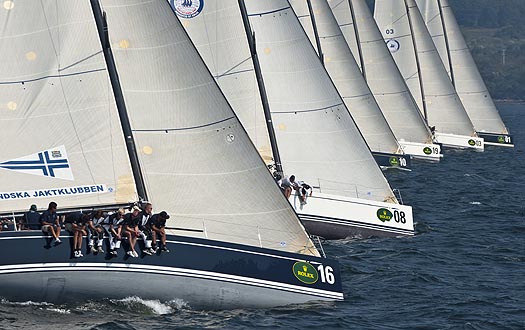
A keen start yesterday. Royal Cork is bow number three. Photo:Dan Nerney/Rolex
"We were probably the biggest movers," said Peter McChesney, helm for the Annapolis Yacht Club team who has only sailed in Newport a handful of times previously, including the the New York Yacht Club Invitational Cup U.S. Qualifying Series in 2010 in which the AYC team finished second to earn the opportunity to race in this event. AYC was 10th overall after yesterday's first day of racing, and moved up to third overall with 43 points after finishes of 6-1-3 today. "We just got off the line better today in every race, and gave our tactician [John Torgerson] the opportunity to make good decisions. If you get a good start it's easier to make those decisions. Our tactician took what we gave him and did a great job of calling tactics, and the crew work was essentially flawless. Everything just went our way."
The exciting conditions seen today on Narragansett Bay have also proven why Newport remains such a unique place to sail. "Where else can you sail in 20 knots of breeze and have the seas be this flat?," said Chip Whipple, timmer on the New York Yacht Club team. "It really is an anomaly. When you have as much breeze as this [in the Med] you're sailing in big seas and a lot of swell. And in northern Europe you have the cold water and big seas, breaking waves. Being as protected as we are here it's just an extremely fantastic place to sail, and the boats can't sail any faster because they are absolutely optimized for the conditions."
The Royal Canadian Yacht Club (RCYC) team has retained the overall lead position after adding finishes of 2-4-2 to yesterday's finishes of 2-1-4 for 15 points. When they won the second race on the first day of the contest, they were given the Rolex gold spinnaker to fly in the subsequent race. And, as overall standings leader, RCYC carried the golden chute for all of today's races, and will continue that way when racing resumes tomorrow.
"We had to bail on two starts," said RCYC helm Terry McLaughlin after racing today, explaining that the RCYC team was forced to tack in both instances but the moves wound up working in their favor. "It was good breeze most of the day and we were going well. We're trying to do all the fundamentals well and not make mistakes." With eleven races planned, and tough competition, McLaughlin knows all to well that the 13-point lead RCYC currently enjoys can disappear in a hurry. "We had a good battle with NYYC in the last race, caught up to them on the last leg. It was close, but they beat us by three boat lengths."
"The last race was a lot of fun," said Ken Colburn, skipper of the New York Yacht Club team when summing up their win of the final race of the day. NYYC now stands second overall with 28 points, 13 points behind RCYC. "We had a great start, found ourselves in a clean lane and just were able to get in the proper groove. RCYC was there every inch of the race. We stayed together . . . gapped the fleet . . . for both of us it was just a fabulous race." Emphasizing that there was still a lot of racing to come, Colburn noted that, as anticipated, the quality and depth of the competition is remarkable. "Six winners in six races is indicative of how strong this fleet is overall."
Racing resumes today Thursday, September 15, with the warning signal for the first race scheduled for 1100. Competitors leave NYYC's Harbour Court for the race course at approximately 0930 each morning. The winner of the 2011 New York Yacht Club Invitational Cup presented by Rolex will be confirmed at the conclusion of racing on Saturday, September 17.
O'Leary Lies Eighth after Day one of New York Cup
Except for an opening race shocker, Royal Cork's Anthony OLeary is counting an excellent third and a fourth from yesterday's races two and three at New York Yacht Club Invitational Cup to lie eighth, one place ahead of the Royal Yacht Squadron in a fleet of 22 entries.
After several practice days spent familiarising themselves with the boats and local sailing conditions, the 22 yacht club teams were unleashed for the first day of racing in the New York Yacht Club Invitational Cup presented by Rolex. The event is hosted by the New York Yacht Club at Harbour Court, their on-the-water clubhouse in Newport, Rhode Island.
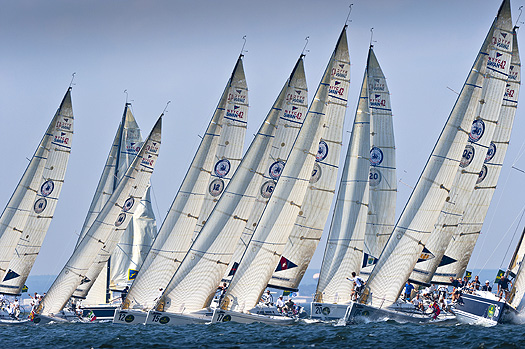
A fleet start yesterday in New York. Photo: Kurt Arrigo/Rolex
For the first day of racing, the NYYC Race Committee opted to send the fleet "inside", up Narragansett Bay. The south-southwest breeze ranged from seven to eight knots, building to the higher teens by the afternoon, and providing perfect conditions for the three races contested. The prevailing wind against an ebbing current kept tacticians in check, though if local knowledge was key you couldn't tell from the results, with teams from the Japan Sailing Federation, Royal Canadian Yacht Club, and Cruising Yacht Club of Australia each taking a win today – and the Canadians at the top of the leaderboard at day's end.
But it was also kudos to the New York Yacht Club Invitational Cup organizers for including several days of practice sailing to get teams up to speed on the Swan 42s, as this one-design given by the technical team, as well as local knowledge briefing provided by Sail Newport Executive Director, Brad Read.
Some teams put the information to use more effectively than others. Patrick Pender, helmsman on the Royal Hong Kong Yacht Club entry which is standing 2nd overall after today said, "It was a great first day for us. I think what was a great thing for the series was that they had a lot of practice racing and allowed the people to really learn how to sail the boat. Often you go to regattas and by the end of the regatta you go, 'crikey, we're ready to go now'. They did a fabulous job yesterday of giving a really, really good explanation about how the tides work both inside (the Bay) and outside. Obviously outside is much more complicated, whereas I think it's probably more predictable up the bay."
Pender's team managed a 3-8-2 today and the helmsman was quick to credit his crew, "The crew's doing an awesome job, mechanically the guys are working very hard. We did a really difficult drop on the last race, coming in hot and fast to the left-hand gate. It was a hard maneuver and we got clear air, had a really good rounding. We sailed very well on the last short beat and protected a good second place finish."
The Japanese entry is one of several returning entries. Having posted a third overall in the 2009 event, the teams' tactician Elichiro Hamazaki, said they are focused on a top three finish again. With a race one win they were on track, but the subsequent 7-9 showed how tough the talent is here. Hamazaki recounted, "We had a good upwind beat, we had a good right-hand shift and kept first position from the top mark. In the second and third races as the wind picked up, the other boats were very consistent and close. Once we made a mistake, we fell behind."
He added, "Especially racing on the inside course, the area is surrounded by shore and the wind is tricky and has big effects of current. It was difficult, but it is very exciting in this one-design class – it's really close, very competitive."
The on-the-water umpiring, introduced for this edition of the Invitational Cup, was put into play today with a half dozen calls made on the water, which served their purpose of eliminating the inevitable protest hearings back onshore.
Winning race three was the Cruising Yacht Club of Australia's entry. Helmsman Hugo Van Kretschmar set his sights on a return to Newport, as his last time was 1983 when he competed in the America's Cup challenger trials onboard the Australian entry, Challenge 12.
Van Kretschmar is part of a group of friends who sail on CYCA Commodore Gary Linacre's and David Fuller's Corby 49. He heard that the CYCA had been invited to compete at the Invitational Cup and hatched a plan to make it happen. Van Kretschmar said "So five of us off the back of Gary's boat decided that we'd like to go and do this thing and we thought we'd like to combine it with the Youth Sailing Academy out of the CYCA. So we have four 'kids' onboard, they're all graduates of the program so 22-, 23-, 24-year olds. So the group was five buddies and four kids out of the Academy. Most of us sailed together in different configurations on different boats and races before, but here in Newport was actually the first time we all sailed together as a team.
Commodore Gary Linacre, who's raced in numerous Rolex Sydney Hobart races, was an enthusiastic supporter of the team, and said, "We looked at the whole deal and I said I'd get behind it as Commodore and do what I could. The three of us (including Van Kretschmar and Fuller) have sailed together lot over the years and we and just decided it's such a wonderful event. The Corinthian nature of it was really worthwhile doing, and so we decided to come here."
Van Kretschmer has another reason for a return to this sailing mecca, " I never saw anything in Newport when I was here in '83. We were on strict lockdown and at the gym at something like five in the morning!"
Racing continues today Wednesday 14 September through Saturday 17 September. Tomorrow's first warning signal will be at 11:00 am.
In addition to Rolex, which for 2011 and 2013 is the presenting sponsor, Sperry Top-Sider and Nautor's Swan have also returned, and are joined by Atlantis WeatherGear, as sponsors to enhance the experience of competitors as well as those who will be following the races.
The 22 entrants
By country, the roster of participating teams is: Yacht Club Argentino (ARG); Cruising Yacht Club of Australia (AUS); Royal Bermuda Yacht Club (BER); Royal Canadian Yacht Club (CAN); Royal Hong Kong Yacht Club (HKG); Real Club Nautico de Barcelona (ESP); Nyländska Jaktklubben (FIN); Itchenor Sailing Club, Royal Ocean Racing Club and Royal Yacht Squadron (GBR); Norddeutscher Regatta Verein (GER); Royal Cork Yacht Club (IRL); Yacht Club Capri and Yacht Club Punta Ala (ITA); Japan Sailing Federation (JPN); Royal Norwegian Yacht Club (NOR); Clube Naval de Cascais (POR); Royal Cape Yacht Club (RSA); Eastern Yacht Club, Annapolis Yacht Club, Newport Harbor Yacht Club and New York Yacht Club (USA).
Foynes Takes Regional RIB Title at Royal Cork
The first of three regional finals of the ISA Yachtsman Euromarine Rib Challenge 2011 was held at Royal Cork Yacht Club last Saturday and it was an exciting start to the competition.
This year the competition was designed to encourage the younger members of our boating community to take to the water in a safe, responsible and most important an enjoyable way. On registration the competition sponsor Matt McGrory who was in attendance started off proceedings in a positive and fun manner by giving each entrant a competition T Shirt and taking a team Photo. This got all teams into a fun and competitive frame of mind.
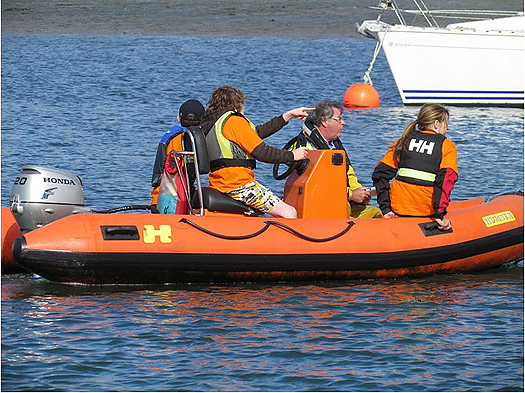
Negotiating the tasks on the Royal Cork RIB course. Photo: Matt McRory
This Regional Final saw the ISA introduce a new format for the competition. Each Team had to carry out 10 tasks in a 3 hour period. These tasks consisted of "on the water maneuvering" of their craft and some off the water activities such as "rescue line throwing, Knots and various questions on all aspects of boating".
For the 3 hour period you could feel the tension as all teams went from task to task, when the time was up ISA RDO Ciaran Murphy had the task of adding up the scores. Throughout the day the high scores in each competition differed with no Team showing dominance. In the end it was a tight affaire and the Top Six were:
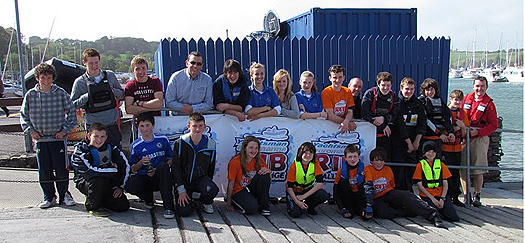
RIB Competitors at Royal Cork
1st Place – Foynes 1
2nd Place – Foynes 2
3rd Place – Royal Cork Yacht Club
4th Place – Glandore Harbour Yacht Club
5th Place - Atlantic Sailing Club
6th Place – Sailing Academy of Ireland
The top four teams now qualify through to the National Final where they have a chance of winning the ISA Yachtsman euromarine Rib Challenge 2011 top prize of a Club Rib.
Ferry Stops, 'Sea Water Baths' on the Way for Dun Laoghaire
The last Stena line ferry sailing from Dun Laoghaire featured on the RTE News headlines last night. The ferry link is stopping because of a decline in passenger numbers and the high cost of fuel, say the operators, Stena.
The report by John Kilraine, interviewed Harbour Boss Gerry Dunne who spoke about the master plan for the harbour, how the harbour company hoped that Stena could rebuild the route, the bid to attract cruise ships and the east coast port's future as a marine leisure centre.
The masterplan is to go through the planning processs piece by piece and harbour yacht clubs have concerns over aspects of the plan.
Last night's bulletin also reported the harbour company intends to open a 'sea water baths' in the harbour next year and a diaspora centre in 2013. The RTE report is here.
See also:
O'Leary Set for Tomorrow's New York Cup
Anthony O'Leary's crew are all set for tomorrow's start of the New York Yacht Club Invitational Cup as sole Irish crew representing Royal Cork Yacht Club in the Big Apple.
The grounds of New York Yacht Club's renowned Harbour Court clubhouse in Newport, Rhode Island, were filled with sailors from around the world, who are set to begin racing tomorrow in the second biennial Invitational Cup presented by Rolex.
The 22 teams, representing yacht clubs from 16 nations and six continents, have traveled far and wide to get to Newport. The teams, especially those less familiar with the Swan 42 class, enjoyed several perfect practice days with today's 12-14 knot southwesterly breeze, under sunshine and brilliant blue skies, appreciated by all competitors, especially those from some more sunshine-challenged locales
The Swan 42s, an ultra competitive one-design class, were conceived by the NYYC as the yacht club's ninth one-design class since its' founding in 1844. The New York Yacht Club Race Committee, led by John "Tinker" Myles, Jr. ran several practice starts today for the fleet.
Racing will run from Tuesday, 13 September through Saturday, 17 September. A total of eleven (windward-leeward) races are planned, with no throw-outs. Racing will take place off Newport, R.I. on Rhode Island Sound or in Narragansett Bay.
One of the first teams to arrive in Newport was Clube Naval de Cascais from Portugal, with skipper Patrick Moteiro de Barros. The team has been on-site for over a week practicing on their chartered Swan 42 Orbit, and making the most of coach Bill Shore's expertise and local knowledge. de Barros commented, "The goal is to do the best we can, and we're here to win. We may not win, but that's the motivation."
To that end de Barros, who is a four-time Olympian, has assembled a crew that at its' core are very competitive Dragon sailors. Included in this mix is tactician Henrique Anjos, a three-time Portuguese national champion in the class. With no Swan 42s available locally, the team came up with a clever alternative last spring, chartering a Dufour 40, and adding a bowsprit to it so they could fly an asymetrical spinnaker.
De Barros is no stranger to Newport, having sailed here in the 1980s when he was the helmsman on Magic, the trial horse for Dennis Conner's Freedom. The team had hoped to participate two years ago, but couldn't come, and the appeal of the event is clear to de Barros who added, "The Invitational Cup is totally Corinthian, and I think it's important to have events where the amateurs are recognized. This is one of the most prestigious yacht clubs in the world, and I think events like this should carry on."
From further afield is the Royal Hong Kong Yacht Club team with skipper Nick Burns. Sailing onboard is Jochim Isler, Vice Commodore of the club and a frequent competitor in the RHKYC's signature biennial Rolex China Sea Race. As with many of the other clubs, the teams experience is in a mix of big boats and one-designs, in this case Etchells. Burns and Isler often compete against each other, but they've solidified their strengths as well as recruited 10 of the top 20 sailors in the club for the team.
In the 2009 event, Royal Hong Kong finished 11th; but last summer they sailed in the Rolex Commodore's Cup and finished second, which Isler said gave them the confidence and motivation to give it a try again.
Burns added, "We came a long way for this, it's great. The event is tightening up (rules) year-by-year, which is what you need. They're doing a very equal job with the boats, it's a very good system. You have nothing to blame but yourself!"
One of the Southern hemisphere teams competing is the Yacht Club Argentino with Paolo Cosentino as helmsman. YCA Commodore Ricardo Galarce is racing onboard as trimmer, and the two were clearly delighted to be here, "This is our first visit and I tell you we are amazed, we want to live here, we're going to stay here."
Cosentino said, "We sail two boats that are similar (a Frers 44 and a Soto 43). We trained about 10 days in Buenos Aires (in the river) and Mar del Plata, where you can sail in the sea. We feel comfortable, but need to train a little more – we've had these three days here, so we'll arrive tomorrow at about 80% of our standard.
"For us we are very proud of being invited by this club. We have a lot of tradition also, our club is almost 130 years old and for us being here is a very special situation – we are very proud."
For NYYC Invitational Cup Event Chairman, John Mendez tomorrow's start couldn't come soon enough, "I'm absolutely delighted. To be honest it's been a long build-up, it's been two years getting this going and to see all of the teams arrive and to meet with them – their excitement and enthusiasm -- has really set this off for me. I feel a lot more relaxed about the whole event!"
About half of the yacht club teams that competed in 2009 are back again, including the top five. Mendez continued, "We still have a lot of interest from yacht clubs that are not here and as this has grown they'll be a lot more who'll want to participate next time. I see the competition this time being stiffer than last time – it has been raised to another level. I think we'll see some exciting racing.
"This is key to each one of these clubs – they all have the intention of taking the trophy back with them. I'm afraid we can't cut it into pieces! But, I could see the trophy leaving our shores at the end of the week."
This edition features a couple of significant changes including a move to all-amateur sailors (no professionals) and on-the-water umpiring. Of the latter Mendez points out, "That's a very big leap forward for fleet racing. We want people to sail safely and the umpiring is definitely going to help that."
In addition to Rolex, which for 2011 and 2013 is the presenting sponsor, Sperry Top-Sider and Nautor's Swan have also returned, and are joined by Atlantis WeatherGear, as sponsors to enhance the experience of competitors as well as those who will be following the races.
The 22 entrants
By country, the roster of participating teams is: Yacht Club Argentino (ARG); Cruising Yacht Club of Australia (AUS); Royal Bermuda Yacht Club (BER); Royal Canadian Yacht Club (CAN); Royal Hong Kong Yacht Club (CHN); Real Club Nautico de Barcelona (ESP); Nyländska Jaktklubben (FIN); Itchenor Sailing Club, Royal Ocean Racing Club and Royal Yacht Squadron (GBR); Norddeutscher Regatta Verein (GER); Royal Cork Yacht Club (IRL); Yacht Club Capri and Yacht Club Punta Ala (ITA); Japan Sailing Federation (JPN); Royal Norwegian Yacht Club (NOR); Clube Naval de Cascais (POR); Royal Cape Yacht Club (RSA); Eastern Yacht Club, Annapolis Yacht Club, Newport Harbor Yacht Club and New York Yacht Club (USA)
Greystones Lead Both Fleets in RS 200/400 Irish Nationals
The championships, which were sponsored by Neil Mathews Architects, saw 18 RS400 boats and 13 RS200s enter. There were five races held over Friday and Saturday, while gusts of nearly 40 knots saw Sunday's races abandoned.
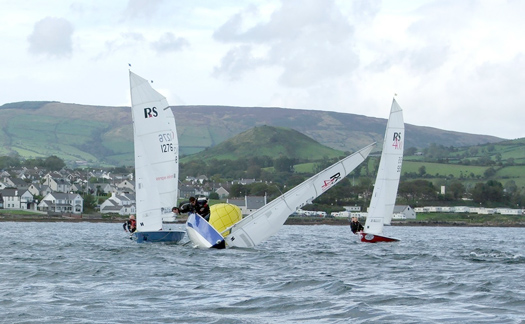
Local sailors John Lowry and Neil Diamond attempt to right their capsized RS400, while Greystones' Fiachra Etchingham and Eoghan Simpson pass the mark at the RS200/400 National Sailing Championships in Cushendall at the weekend
Roy Van Maanen and Glen Reid from Greystones Sailing Club led the RS200 fleet, bagging three firsts, a second and a third. In second place were Trevor Fisher and Heather King from Royal St George Yacht Club in East Down. And then it was Greystones again, with Sean Cleary and Steven Tyner amassing a first, second, third and two fourth place finishes to end up in third place overall.
Paul McLaughlin and Mick McKinley were first home from the five local crews that took part in the RS400 class, finishing fifth overall.
Gerry and Avril Cannon lifted a prize as the first mixed crew home in the 400s, while Sarah and Ciara Byrne in an RS200 were the first all-woman crew home.
Richard Doig and Dr Michael Hill from East Antrim Boat Club kindly officiated as Race Officer and Assistant Race Officer for the series.
J24 Euros Open in Howth, Strong Winds Cancel Practise Race
The BMW J/24 European Championships were officially opened last night with a ceremony on the forecourt in front of the Howth Yacht Club clubhouse on the podium erected by the sponsor but a practise race scheduled for this afternoon was cancelled due to strong winds.
Last night's openning ceremony featured two top-of-the range BMW vehicles and a motorcycle and a backdrop with the highly appropriate phrase of 'Joy is Plain Sailing' in front of the national flags of the nine competing nations.
With an audience of competitors, supporters and club members, the speakers on the podium were introduced by the 'Master of Ceremonies', Club and Championship Press Officer Graham Smith.
First to speak was Derek Bothwell, Chairman of the Championship Organising Committee, and then the Commodore Roger Cagney addressed the large crowd who has assembled on the forecourt and balcony. They were followed by John Ives, Managing Director of BMW Ireland, the title sponsors, who spoke about BMW's global involvement in sailing, and then Niamh McCutcheon, President of the Irish Sailing Association, spoke on behalf of the ISA and the Irish Sports Council who supported the event.
Jim Farmer, President of the World Council of the International J/24 Class Association, spoke next, and the final speaker was the Mayor of Fingal, Cllr.Gerry McGuire, who welcomed all the overseas visitors to the county and officially declared the Championship open.




























